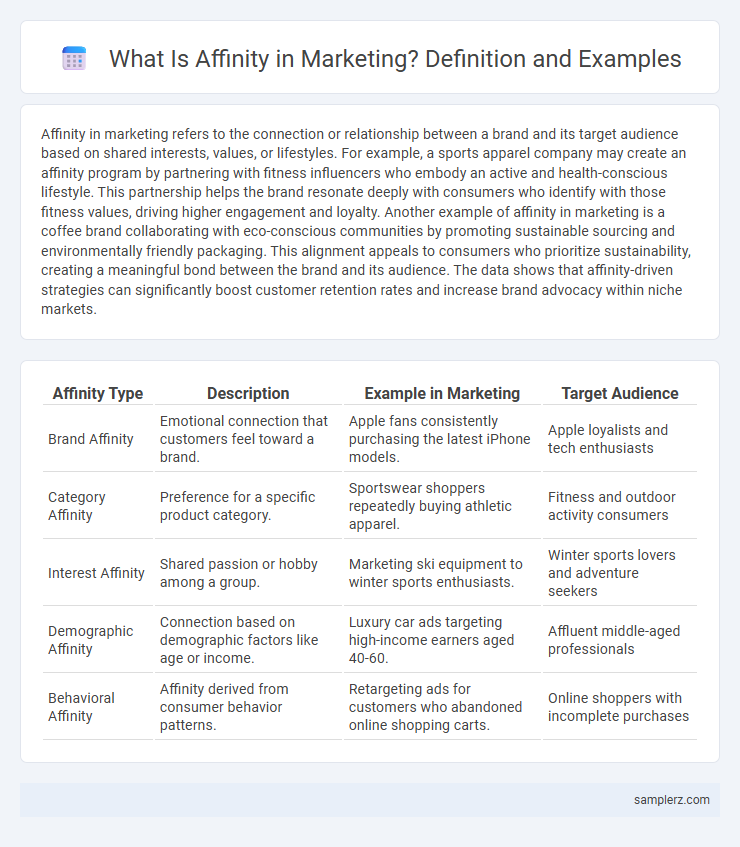Affinity in marketing refers to the connection or relationship between a brand and its target audience based on shared interests, values, or lifestyles. For example, a sports apparel company may create an affinity program by partnering with fitness influencers who embody an active and health-conscious lifestyle. This partnership helps the brand resonate deeply with consumers who identify with those fitness values, driving higher engagement and loyalty. Another example of affinity in marketing is a coffee brand collaborating with eco-conscious communities by promoting sustainable sourcing and environmentally friendly packaging. This alignment appeals to consumers who prioritize sustainability, creating a meaningful bond between the brand and its audience. The data shows that affinity-driven strategies can significantly boost customer retention rates and increase brand advocacy within niche markets.
Table of Comparison
| Affinity Type | Description | Example in Marketing | Target Audience |
|---|---|---|---|
| Brand Affinity | Emotional connection that customers feel toward a brand. | Apple fans consistently purchasing the latest iPhone models. | Apple loyalists and tech enthusiasts |
| Category Affinity | Preference for a specific product category. | Sportswear shoppers repeatedly buying athletic apparel. | Fitness and outdoor activity consumers |
| Interest Affinity | Shared passion or hobby among a group. | Marketing ski equipment to winter sports enthusiasts. | Winter sports lovers and adventure seekers |
| Demographic Affinity | Connection based on demographic factors like age or income. | Luxury car ads targeting high-income earners aged 40-60. | Affluent middle-aged professionals |
| Behavioral Affinity | Affinity derived from consumer behavior patterns. | Retargeting ads for customers who abandoned online shopping carts. | Online shoppers with incomplete purchases |
Understanding Affinity in Marketing
Understanding affinity in marketing involves recognizing the strong emotional connection consumers have with a brand, product, or service. Brands like Apple leverage affinity by creating loyal customer communities through consistent quality, innovative technology, and exceptional user experiences that resonate with their target audience's values and lifestyle. This emotional bond drives repeat purchases, word-of-mouth referrals, and long-term brand loyalty, making affinity a powerful tool for marketers aiming to deepen customer relationships.
The Role of Affinity Groups in Brand Loyalty
Affinity groups, such as hobbyist clubs or professional associations, play a crucial role in enhancing brand loyalty by creating a community around shared interests and values. Brands that engage with these groups through targeted messaging and exclusive offers foster deeper emotional connections, leading to increased customer retention. Leveraging affinity groups enables marketers to tailor campaigns that resonate authentically, driving long-term brand advocacy.
Real-World Examples of Affinity Marketing
Affinity marketing thrives through partnerships like the collaboration between Starbucks and Spotify, where Starbucks offers Spotify playlists in-store, enhancing customer experience and driving brand loyalty. Another prime example is the alliance between Nike and Apple, integrating fitness tracking technology with athletic wear to target tech-savvy consumers passionate about fitness. These examples highlight how affinity marketing leverages shared interests to create mutually beneficial customer engagement and boost brand affinity.
Leveraging Shared Interests for Campaign Success
Leveraging shared interests in marketing campaigns enhances brand affinity by connecting with consumers on a personal level, fostering loyalty and engagement. Brands like Nike utilize affinity marketing by aligning with sports enthusiasts through sponsored events and athlete endorsements, creating authentic community bonds. This strategy drives higher conversion rates as campaigns resonate deeply with target audiences who identify with the shared passions promoted.
Case Studies: Famous Affinity Marketing Campaigns
Coca-Cola's "Share a Coke" campaign is a prime example of affinity marketing, leveraging personalized names on bottles to create emotional connections with consumers and boost engagement. Nike's collaboration with Apple for the Nike+ app combined fitness and technology brands to target health-conscious, tech-savvy audiences, enhancing brand loyalty on multiple fronts. Another notable case is Red Bull's association with extreme sports events, which aligns the brand with adrenaline-fueled lifestyles, perfectly matching its energetic identity and consumer passions.
How Brands Build Affinity with Target Audiences
Brands build affinity with target audiences by creating personalized experiences that resonate with consumers' values and lifestyles, such as Nike's promotion of empowerment through sport. Leveraging social media platforms allows brands like Starbucks to engage authentically and foster community among customers. Emotional storytelling in campaigns, exemplified by Dove's Real Beauty initiative, strengthens trust and deepens connections with the audience.
Affinity Partnerships: Collaborating for Greater Reach
Affinity partnerships in marketing involve brands collaborating with organizations that share similar values or target audiences, amplifying their reach and engagement. For example, Nike partnering with fitness apps like Strava creates a seamless connection with health-conscious consumers, enhancing brand loyalty and market penetration. These collaborations leverage shared customer bases to drive mutual growth and build stronger community ties.
Personalization Through Affinity Segmentation
Affinity segmentation enhances marketing effectiveness by dividing audiences based on shared interests and lifestyle preferences, enabling personalized content delivery. Brands tailor messages to specific affinity groups, such as fitness enthusiasts or tech lovers, increasing engagement and conversion rates. Utilizing data from social media behavior and purchase history refines targeting, fostering deeper customer connections and loyalty.
Measuring the Impact of Affinity in Marketing
Measuring the impact of affinity in marketing involves analyzing customer engagement metrics such as click-through rates, repeat purchase frequency, and brand loyalty indices to determine the strength of emotional connections. Utilizing tools like customer segmentation, sentiment analysis, and net promoter scores (NPS) helps quantify how affinity influences long-term revenue growth and customer lifetime value (CLV). Marketers also track social media interactions and referral rates to evaluate the effectiveness of affinity-based campaigns in driving organic brand advocacy.
Future Trends in Affinity-Based Marketing
Future trends in affinity-based marketing emphasize leveraging AI-driven data analytics to create hyper-personalized customer segments based on shared interests and behaviors. Brands increasingly integrate virtual and augmented reality experiences to deepen emotional connections within affinity groups. The rise of blockchain technology enhances transparency and trust, enabling marketers to build more authentic affinity networks.

example of affinity in marketing Infographic
 samplerz.com
samplerz.com